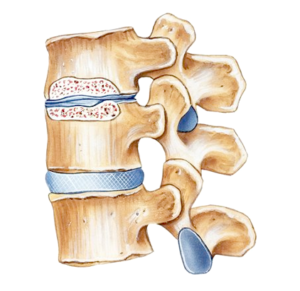What is Spinal Narrowing?
Spinal narrowing, which is also known as spinal stenosis, can result from injury to the spine, overuse of the neck and back, an inherited condition, or from age-related degeneration of components of the spinal anatomy. A number of issues can reduce the size of the spinal canal that encases the spinal cord, or of the openings, known as foramina, that allow nerve roots to exit the spinal column.
Conditions that can crowd spaces in the spine include bone spurs, osteoarthritis, degenerative disc disease, and others. Spinal stenosis typically does not exhibit symptoms unless the restricted space leads to irritation or compression of a nerve root or the spinal cord. Whether you have been diagnosed with this condition or are researching the potential causes of your neck or back pain, it is important to educate yourself as a patient. The following information about spinal narrowing can help you better work with your doctor to find lasting relief.

Risks of Spinal Narrowing?
Although a neck or back injury can lead to spinal stenosis in people of any age, most spinal narrowing can be found in people who are middle-aged or older. This is because the spinal anatomy is subjected to a wide range of stress-inducing movement over time, including bending, twisting and turning. It is these movements that can partially contribute to the parts of the spine naturally degenerating as a person ages. The vertebrae, discs, ligaments, muscles and joints of the spine naturally begin to wear down and compress, and issues such as bone spurs, herniated discs and hardened ligaments are fairly common results. This natural spinal deterioration tends to contribute directly to the narrowing of the spinal column. Some common risk factors for developing spinal stenosis include:
- Genetics. Inherited traits can make certain people more vulnerable to spinal stenosis, and in rare cases, some people are born with an abnormally narrow spine.
- Age. People who are 50 or older are more likely to develop stenosis of the spine.
- Obesity. Excess body weight places more stress on the spinal column, which can lead to instability and tissue damage.
- Smoking. Ingredients in cigarette smoke can break down tissues in the spine.
- Injury history. A spinal injury that is experienced early in life can affect spinal stability later on.
Symptoms of spinal narrowing
Spinal narrowing doesn’t always produce symptoms. In fact, unless the spinal canal or foramina becomes so narrow that it starts to compress the spinal cord or one of the nerves that branch out of it, the narrowing can go undetected for years.
However, if the spinal canal narrows to the point of the spinal cord or nerve root compression, a person might experience one or more of the following symptoms:
- Localized pain. For example, if the compression is occurring in the cervical (upper) spine, pain might be felt in the neck; if it is occurring in the thoracic (middle) spine, pain might be felt in the center back or torso; if it is occurring in the lumbar (lower) spine, pain might be felt in the lower back.
- Radiating pain. This is pain that travels along the affected nerve. Nerves in the cervical spine branch out through the shoulders and arms, while nerves in the lumbar spine branch down through the hips, legs, and feet.
- Numbness or tingling. These symptoms often occur in the upper or lower extremities, such as the fingers and toes.
- Sciatica. Radiating leg pain, numbness and weakness that occurs only if spinal narrowing causes compression of the sciatic nerve.
Patients who do experience these symptoms should meet with their primary care physician for individualized recommendations for treatment.
Treatment for Spinal Narrowing
Typically, symptoms associated with spinal stenosis can be managed with conservative treatments which can provide lasting relief for many patients dealing with these conditions. These conservative options include:
- Medications. There are many medications that a doctor might recommend for a patient with spinal narrowing. Over-the-counter pain relievers, such as acetaminophen, and anti-inflammatory medications, such as ibuprofen, are the most common. Prescriptions can also be written for patients with more severe symptoms.
- Exercise. Walking, swimming and other forms of low-impact exercise can be highly beneficial for reducing pain, while yoga, Pilates and other stretching-based exercises can help patients expand their range of motion. Strengthening exercises can also help the muscles around the spine to promote better overall health.
- Physical therapy. While a personal exercise plan is often recommended, physical therapy sessions can also help patients manage the symptoms of spinal narrowing. A trained physical therapist can teach a patient techniques for reducing pain during normal daily activities, as well as exercises that can help improve flexibility and muscle tone.
- Rest and lifestyle changes. When the spinal cord or a nerve root is compressed, certain activities or motions may make pain worse. Avoiding these activities, or modifying the way in which they are performed, can help patients deal with the symptoms of spinal narrowing. Posture improvement or beginning a weight-management plan may also be recommended.
Some patients also pursue alternative therapies, such as chiropractic care, acupuncture, hydrotherapy, and therapeutic massage. When provided by a reputable practitioner, these options can help supplement a patient’s conservative treatment plan. However, while alternative and conservative treatments can provide significant short-term pain relief, these options cannot prevent or reverse spinal narrowing. If a patient’s spinal stenosis continues to get worse — or their symptoms continue to progress — surgery may be necessary to create additional space in the spinal canal.
Surgery for spinal narrowing
If chronic neck or back pain persists despite exhaustive conservative treatment, surgery may become an option. A surgeon will evaluate each patient’s condition to determine if an operation is the best option for creating more space in the spinal canal or to decompress an affected nerve.